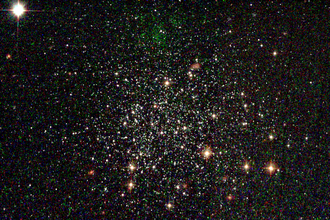Palomar 4
|
Globular cluster Palomar 4 |
|
|---|---|

|
|
| Photo from the Hubble Space Telescope | |
| AladinLite | |
| Constellation | Big Bear |
|
Position equinox : J2000.0 , epoch : J2000.0 |
|
| Right ascension | 11 h 29 m 17 s |
| declination | + 28 ° 58 ′ 25 ″ |
| Appearance | |
| Concentration class | XII |
| Brightness (visual) | +14.2 mag |
| Angular expansion | 2.1 ' |
| Physical data | |
| Affiliation | Milky Way (outer halo ) |
| Radial velocity | 72.4 km / s |
| distance | 354.4 kLj (108.7 kpc ) |
| Concentration lg (r t / r c ) | 0.78 |
| Age | 9.5 ± 1.6 years |
| Metallicity [Fe / H] | −1.48 |
| history | |
| Catalog names | |
| C 1126 + 292 • GCl 17 • Pal 4, UGCA 237; formerly: Ursa Major Dwarf Galaxy | |
Palomar 4 (short: Pal 4 ) is a globular star cluster in the constellation Great Bear . Pal 4 was discovered by Edwin Hubble in 1949 and found again a year later by Albert George Wilson .
Initially, Pal 4 was temporarily classified as a dwarf galaxy . However, it was later found to be a globular cluster. The brightest single stars have an apparent magnitude of 18 mag.
Web links
Individual evidence
- ^ A b c d William E. Harris: A Catalog of Parameters for Globular Clusters in the Milky Way . In: Astronomical Journal . tape 112 , no. 4 , 1996, pp. 1487–1488 , doi : 10.1086 / 118116 , bibcode : 1996AJ .... 112.1487H .
- ^ A b Eugene Vasiliev: Proper motions and dynamics of the Milky Way globular cluster system from Gaia DR2 . In: Monthly Notices of the Royal Astronomical Society . tape 484 , no. 2 , 2019, p. 2832–2850 , doi : 10.1093 / mnras / stz171 , arxiv : 1807.09775 , bibcode : 2019MNRAS.484.2832V .
- ↑ M. Salaris, A. Weiss: Homogeneous age dating of 55 Galactic globular clusters. Clues to the Galaxy formation mechanisms . In: Astronomy and Astrophysics . tape 388 , 2002, p. 492–503 , doi : 10.1051 / 0004-6361: 20020554 , arxiv : astro-ph / 0204410 , bibcode : 2002A & A ... 388..492S .
- ↑ www.skyhound.com